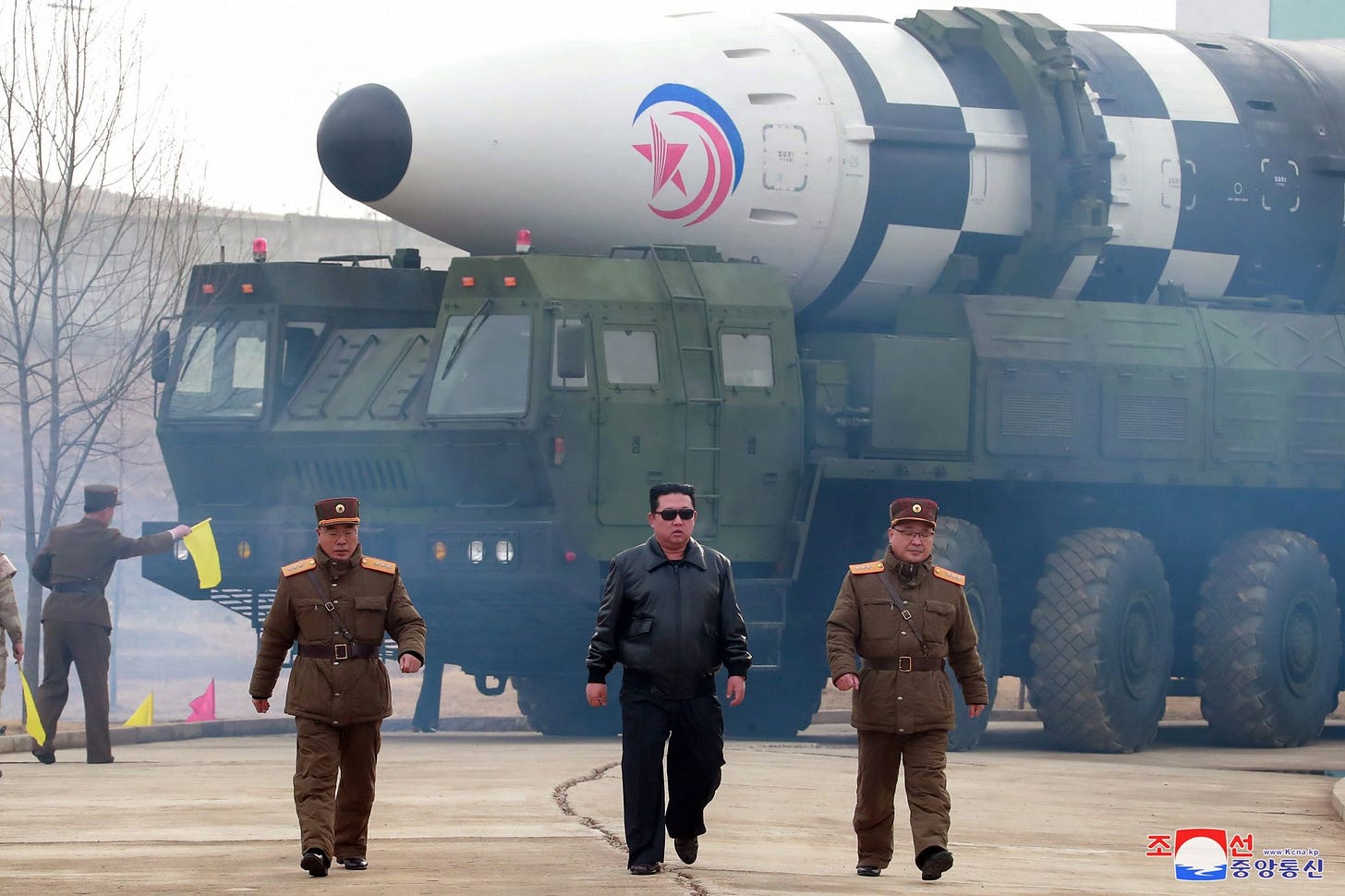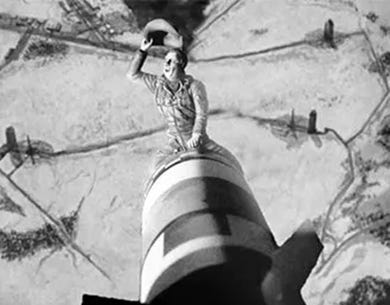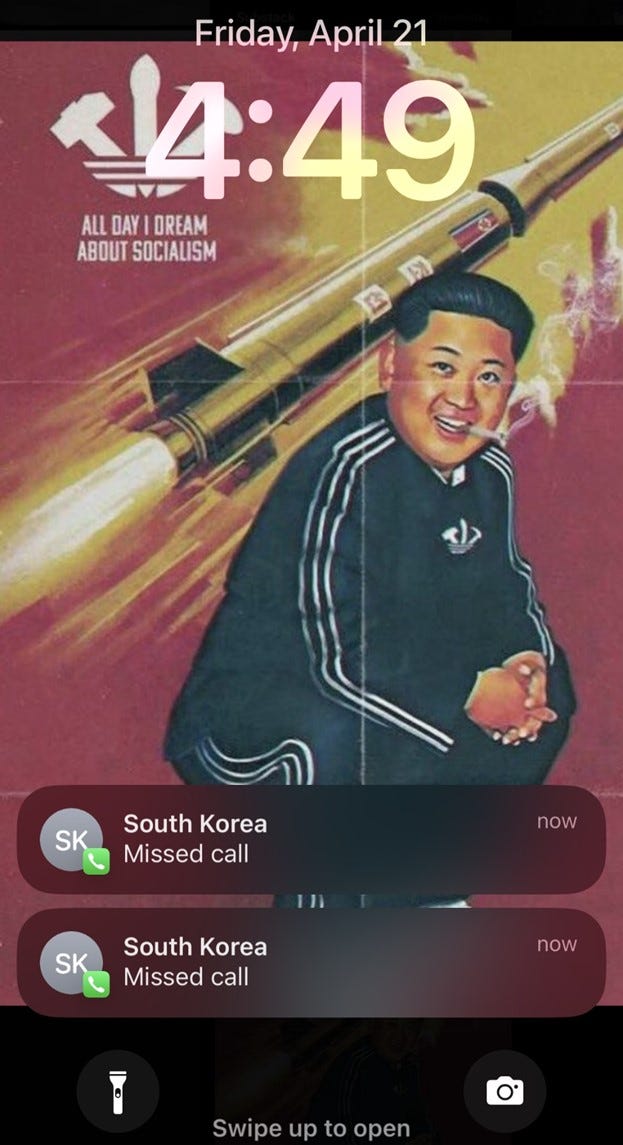2022 was a bumper year for geopolitics. With the spotlight of world leaders focused on Ukraine and Taiwan last year, North Korea capitalized on the situation for an unprecedented year in advancing its military posturing.
From a technological standpoint, North Korea is making advancements towards developing solid-fuel missile capabilities. This would be a significant step forward for their military. Old tech liquid-fuel missiles are much more vulnerable to monitoring and take quite a while to prepare for launch as they cannot be kept in a constant state of readiness. Whereas solid-fuel missiles have a short time to prepare for blast off meaning there is a tight window to pre-empt, prepare and counter. None of this would matter unless North Korea had the potential to stick something dangerous onto the tip of these missiles. Unfortunately in this case, the “something dangerous” could be a nuclear weapon.
Russia’s invasion of Ukraine and Putin’s ongoing threat of using nuclear weapons, has reinforced North Korea’s view of the importance of nuclear weapons. In my earlier piece, “The Russian Bear’s Bald Spot: Part 2”, I discussed the dangers around dealing with a nuclear armed crackpot – akin to dealing with a crazed Mike Tyson after he took a chunk out of Holyfield’s ear.
Without nukes, Western support and pressure on Russia could be ramped up as there is no fear of a nuke being launched out of desperation from Russia. North Korea has been observing and taking notes of proceedings which only confirms in their mind that they will be exposed without straddling a nuclear bomb between their legs.
With an emboldened North Korea and a few historic dates in the calendar coming up (as discussed in Part 2), many around the peninsula are getting nervous, particularly the South Koreans.
Domestically in South Korea, a study was done a few months ago by the Chey Institute for Advanced Studies which found record high support of 76% in favour of South Korea developing its own nuclear capabilities. For South Korea to go ahead with such a move, they would first have to overcome regional opposition and risk stoking tensions even further. This makes it unlikely, but not an impossibility.
Instead of getting their own hands dirty in radioactive material, South Korea could formally request their buddy, the US, to redeploy nuclear weapons in its country which were withdrawn after the Soviet Union collapsed in 1991. This option would be highly contentious as placing nuclear weapons in China’s and Russia’s backyard would spike tensions with the superpowers.
Only a few months ago in January, the South Korean President officially mentioned the possibility of arming up with nukes to combat the rising threat to the north. This comment itself was historical as it is the first time a South Korean President even mentioned nuclear weapons as an option since the US withdrew theirs back in 1991.
Besides from South Korea having nervous poos worrying about the whole situation, there are other geopolitical players who are spending equivalent amounts of time on their respective toilets contemplating what to do.
China’s President Xi half-heartedly continues to support the North Korean regime. If a war broke out, China would likely have to send support to prop up the regime. The alternative would be to accept a united Korea partnered with America on its backdoor step. This wasn’t acceptable in 1950 (as discussed in Part 1), and with tensions between China and the US now at record highs, it certainly would not be acceptable now. Any outbreak of war would also result in millions of refugees pouring across the Yalu River in the north into China. This is a headache President Xi can do without. On the flip side, Xi does not want North Korea progressing any further with its nuclear program. The next step would be a 7th test, which due to the geographical proximity of China and North Korea, the tremors of such a blast would be felt in China’s north-eastern region which would spook the locals.
The last test in 2017 was the equivalent of a 6.3-magnitude earthquake. This triggered a wave of criticism by Chinese locals who were rocked by the blast in their homes and called for diplomatic relations between China and North Korea to be severed. While China’s President Xi is currently busy making wider moves on the global geopolitical chessboard as of late, he could do without a domestic issue like this again at home.
Any further nuclear escalation by North Korea could also push the other players in the region such as South Korea or Japan to get their own nuclear weapons, which is something China would not want either for fear the weapons could be pointed at them instead of North Korea.
This means the best option for China is for the status quo to remain with no further escalations or change to the regime. A different leader of North Korea could have different views or a different approach. As the saying goes:
“better the devil you know than the devil you don’t”.
As for the US, they remain trapped with one foot stuck in this mess of a situation. They currently have 28,000 US troops stationed in South Korea. Attempting to pull its foot out by withdrawing the troops would strain its alliances with other countries in the region such as Japan and Taiwan who believe in US security over their sovereignty. This could also energize Kimmy and his army into thinking the time has come for pressing on and going toe-to-toe with South Korea to gain control of the entire peninsula.
Alternatively, the other option for the US is to increase its presence in the region and external pressure on the regime. There is limited political appetite for committing more troops to the region and as described in Part 2, additional external pressure in the form of sanctions will yield little results.
To overcome the domestic political resistance to committing more troops and resources to South Korea, it could be packaged and sold as a strategy to forward position troops and supplies closer to Taiwan in case China makes a move on the island. However, the US would still have to get the South Koreans to agree to an increased presence. Unfortunately for the US, this conversation might be a little awkward seeing as they just got caught with their pants around their ankles spying on South Korea. In a recent major leak of classified documents from the CIA, highly sensitive intel regarding South Korea was leaked where the source was cited as “signal intelligence”, which means the US were likely taping the phones of South Korean officials. Not ideal for the bromance, to say the least.
In a recent development, during the week on Wednesday, the US and South Korea ironed out this hiccup in the relationship when the South Korean president visited The White House. The highlight of this visit was the South Korean president singing “American Pie” to Biden. Secondary to this moment, they also signed an agreement for the US to dock nuclear submarines in South Korea a few times per year which signals the growing concern Western allies have for the situation.
Other than a few naval-spooking missions during the year, alternative escalatory and de-escalatory options are limited. Just like the other players, the US remains stuck with the devil they know.
The Japanese sit nervously on the side-line because they know if there were any developments on the Korean peninsula, they would likely be dragged into it. Similar to China, the floodgates of Korean refugees fleeing the war would crash open. Despite not seeing eye-to-eye with the South Koreans over their history on the peninsula, Japan is partnered with America. In this complicated threesome relationship, as America would be dragged into the scrap, Japan would be obligated to follow suit.
Staying out of the scrap wouldn’t exactly mean complete safety either for Japan who sit right across the pond from Korea. North Korea has already tested missiles that can reach the Pacific Ocean, which pass directly over Japan’s capital, Tokyo. Earlier this month, on April 13th North Korea launched a missile with a trajectory towards Japan that initially spooked the Japanese so much, that they called an evacuation warning across their northern island of Hokkaido – which is equivalent in size to the entire island of Ireland. The missile fell into the sea before reaching Japan but this was after it had already annoyingly ruined everyone’s Thursday morning breakfast. How rude.
South Korea remains the most at risk here. It’s capital, Seoul, is only about 50km from the border with North Korea whereas Pyongyang is over 200km from the border. This close proximity for South Korea’s capital, where around half of its 51 million population live, means South Korea has no strategic depth. The importance of this was shown at the beginning of the Ukraine War. Ukraine’s capital Kyiv has the benefit of being far from its borders which stood to its successful defense in the initial wave of attack from the Russians. This strategic depth from the front lines stretched the Russian supply lines and gave Ukrainian military commanders the breathing room to see where and how the Russians were advancing so they could prepare accordingly to stall their advance and push them back. The government in Seoul has no such advantage. Chaos would be unleased within minutes.
It is reported that the North Koreans have 10,000 artillery pieces dug in along the border, with many hidden in bunkers and caves. The barrage of a full attack from the north would do apocalyptic damage as millions began fleeing south before any counteroffensive could be launched. This is the scenario of a sudden escalation of events, however the other option is a de-escalation of tensions by working towards unification of the entire peninsula into one country. There is limited appetite for this among the wealthy South Koreans as their prosperity would then need to be shared with their new fellow, extremely poor citizens.
The best solution here would be for the South and North Koreans to talk it out and kiss and make-up. To accommodate the possibility of this, both countries hold twice-daily phone calls with each other. With one in the morning and one in the afternoon, representatives of each country check-in with each other. Asking about the weather, how each other’s days are going and maybe telling a few funny stories. Besides the chit-chat and gossip, the reason for this, is to prevent a clash along the countries’ border by making sure there are no surprises and a good line of communication remains open between the two. North Korea, as of the last three weeks, has stopped answering the twice-daily calls. Using a term I just made up, this is “Geopolitical Ghosting” at its finest.
Each country has their own geopolitical concerns but the solution consistently points towards maintaining the status quo. For a world leader to publicly speak about the day North Korea could explode or implode, they risk creating a self-fulfilling prophecy by expediting that day and making it a reality. With all the uncertainties and risks surrounding the problem of North Korea, for now and for the foreseeable, the North Korean can continues to be kicked down the road.
More to come, subscribe below.






